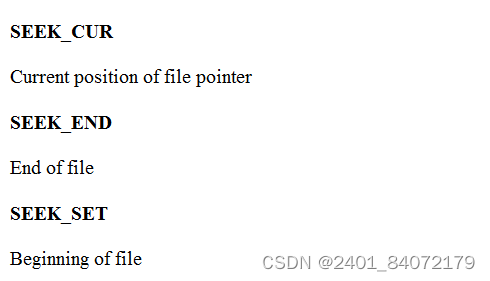程序文件
源程序文件(后缀为.c)
目标文件(Windows环境后缀为.obj)
可执行文件(Windows环境后缀为.exe)
fputc
FILE* pf = fopen("test.txt","w");
if (pf == NULL)
{
printf("%s\n", strerror(errno));
return 1;
}
//写文件
char i = 0;
for (i = 'a'; i <= 'z'; i++)
{
fputc(i, pf);
}
fgetc
FILE* pf = fopen("test.txt","r");
if (pf == NULL)
{
printf("%s\n", strerror(errno));
return 1;
}
//读文件
int ch = 0;
while ((ch=fgetc(pf)) != EOF)
{
printf("%c ",ch);
}
fputs
FILE* pf = fopen("test.txt","w"); //w在文件打开的时候就清理掉数据了
//写文件的时候,如果有内容,会销毁再重新写数据
//FILE* pf = fopen("test.txt", "a"); 写a可以实现追加
if (pf == NULL)
{
printf("%s\n", strerror(errno));
return 1;
}
//写一行数据
fputs("hello world\n", pf);
fgets
FILE* pf = fopen("test.txt","r");
if (pf == NULL)
{
perror("fopen");
return 1;
}
//读一行数据
char arr[20];
fgets(arr, 5, pf); //读5个字符,但自己加一个\0,实际读四个
printf("%s\n", arr); //hello中只读了hell
fprintf
printf是打印输出到屏幕,fprintf是打印输出到文件。
struct s
{
char arr[10];
int age;
float score;
};
int main()
{
struct s s = { "zs",22,23.3f };
FILE* pf = fopen("test.txt","w");
if (pf == NULL)
{
perror("fopen"); //fopen是自己加的
return 1;
}
fprintf(pf,"%s %d %f", s.arr, s.age, s.score);
//关闭文件
fclose(pf);
pf = NULL;
return 0;
}
fscanf
格式化输入函数
struct s s = { 0 };
FILE* pf = fopen("test.txt","r");
if (pf == NULL)
{
perror("fopen"); //fopen是自己加的
return 1;
}
fscanf(pf, "%s %d %f", s.arr, &(s.age), &(s.score));
printf("%s %d %f", s.arr, s.age, s.score);
流
任何一个c程序,只要运行起来,就会默认打开三个流
它们的类型都是FILE*
FILE* stdin - 标准输入流 (键盘)
FIEL* stdout - 标准输出流(屏幕)
FILE* stderr - 标准错误流(也是屏幕)
fprintf(stdout,"%s %d %f", s.arr, s.age, s.score); //打印到屏幕上去
fwrite
以二进制的形式写进文件中
struct s s = {"zhangsan",25,50.5f};
FILE* pf = fopen("test.txt","wb");
if (pf == NULL)
{
perror("fopen");
return 1;
}
fwrite(&s, sizeof(struct s), 1, pf);
fread
以二进制的方式读
struct s s = {0};
FILE* pf = fopen("test.txt","rb");
if (pf == NULL)
{
perror("fopen");
return 1;
}
fread(&s, sizeof(struct s), 1, pf);
printf("%s %d %f", s.arr, s.age, s.score);
scanf是针对标准输入的格式化输入语句
printf是针对标准输入的格式化输出语句
fscanf是针对所有输入流的格式化输入语句
fprintf是针对所有输入流的格式化输出语句
sscanf从一个字符串中转化成一个格式化的数据 (序列化)
sprintf 把一个格式化的数据转化成字符串(反序列化)
struct s s = {"zhangsan",20,55.5f};
struct s tmp = { 0 };
char buf[100] = { 0 };
sprintf(buf, "%s %d %f", s.arr, s.age, s.score);
//sprintf 把一个格式化的数据写到字符串中,本质是把一个格式化的数据转换成字符串
printf("%s\n", buf);
sscanf(buf, "%s %d %f", tmp.arr, &(tmp.age), &(tmp.score)); //从字符串中获取一个格式化的数据到tmp中
printf("%s %d %f\n", tmp.arr, tmp.age, tmp.score);

fseek定位文件指针,ftell计算当前文件指针的偏移量
fseek(pf, 2 ,SEEK_SET); //文件内容abcdef 直接定位到c
int ch = fgetc(pf);
printf("%c ", ch);
printf("%d\n", ftell(pf)); //3
fseek(pf, 2, SEEK_CUR); //文件内容abcdef 直接定位到f
ch = fgetc(pf);
printf("%c ", ch);
printf("%d\n", ftell(pf)); //6
fseek(pf, -1, SEEK_END);
ch = fgetc(pf);
printf("%c ", ch);
printf("%d\n", ftell(pf)); //6
rewind让文件指针位置回到文件起始位置
rewind(pf);
ch = fgetc(pf);
printf("%c ", ch); //a
feof应用于当文件读取结束的时候,判断是读取失败结束还是文件尾结束
文本文件读取是否结束判断,判断返回值是否为EOF或者NULL
fgetc判断是否为EOF
fgets判断返回值是否为NULL
二进制文件的读取结束判断判断返回值是否小于实际要读的个数
fread判断返回值是否小于实际要读的个数
//判断是什么原因结束的
if (ferror(pf))
{
puts("I?O error when reading ");
}
else if (feof(pf))
{
puts("end of the file reached successfully");
}
文件缓冲区
因为有缓冲区的存在,C语言在操作文件的时候,需要做刷新缓冲区或者在文件操作结束的时候关闭文件
如果不做,可能导致读写文件的问题





















 531
531











 被折叠的 条评论
为什么被折叠?
被折叠的 条评论
为什么被折叠?








